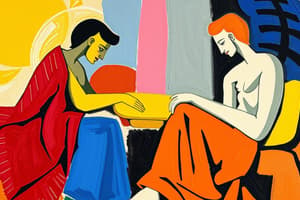Podcast
Questions and Answers
What does Classical Ideal #1 refer to?
What does Classical Ideal #1 refer to?
Classical art is enduring (dealing with antiquities).
What is the focus of Classical Ideal #2?
What is the focus of Classical Ideal #2?
Classical art is governed by rules based on measurement and proportion (symmetry).
What are the Rules in Classical Ideal #3 based on?
What are the Rules in Classical Ideal #3 based on?
The Rules are based on God's creation in nature.
What is Greek Classical Ideal #1 related to?
What is Greek Classical Ideal #1 related to?
What does Greek Classical Ideal #2 pertain to?
What does Greek Classical Ideal #2 pertain to?
Greek Classical Ideal #3 refers to what type of art?
Greek Classical Ideal #3 refers to what type of art?
What does The Parthenon signify in terms of classical ideals?
What does The Parthenon signify in terms of classical ideals?
What is the significance of The Spear-Bearer in classical sculpture?
What is the significance of The Spear-Bearer in classical sculpture?
What does Black & Red Figure Pottery emphasize?
What does Black & Red Figure Pottery emphasize?
What is the definition of the Classical Ideal in visual arts?
What is the definition of the Classical Ideal in visual arts?
Which features are characteristics of Polykleitos' Doryphoros (Spear-Bearer)?
Which features are characteristics of Polykleitos' Doryphoros (Spear-Bearer)?
Which of the following are Renaissance Classical Ideals?
Which of the following are Renaissance Classical Ideals?
Who is credited with the development of Linear Perspective?
Who is credited with the development of Linear Perspective?
Who mastered Chiaroscuro?
Who mastered Chiaroscuro?
What does sfumato refer to in Renaissance art?
What does sfumato refer to in Renaissance art?
What does Color Theory encompass?
What does Color Theory encompass?
What is the focus of depth of field in sfumato?
What is the focus of depth of field in sfumato?
What is the definition of chiaroscuro?
What is the definition of chiaroscuro?
What are the elements of Classical Ideals?
What are the elements of Classical Ideals?
What does the perfection of the High Renaissance involve?
What does the perfection of the High Renaissance involve?
Vasari's view of the Renaissance includes 3 periods: nursery, childhood, and ______.
Vasari's view of the Renaissance includes 3 periods: nursery, childhood, and ______.
What does Renaissance emphasize from Minor?
What does Renaissance emphasize from Minor?
What does Concetto refer to in art?
What does Concetto refer to in art?
What does Disegno encompass?
What does Disegno encompass?
What is Brunelleschi known for?
What is Brunelleschi known for?
What techniques did da Vinci master?
What techniques did da Vinci master?
Flashcards are hidden until you start studying
Study Notes
Classical Ideals in Art
- Classical art is characterized by its enduring nature, rooted in antiquities.
- Governed by rules of measurement and proportion, highlighting the importance of symmetry.
- Classical principles are derived from God's creation in nature.
Greek Classical Ideals
- Architecture: The Parthenon exemplifies architectural excellence with its enduring influence and emphasis on symmetry.
- Sculpture: The Spear-Bearer, created by Polykleitos, represents a canon of sculpture with lifelike qualities and realistic anatomy.
- Two-dimensional Art: Greek pottery features distinctive Black and Red figure techniques, emphasizing symmetry and beauty.
The Parthenon
- Influential in the history of architecture, it embodies peace, beauty, and order through symmetry.
- Its design draws inspiration from nature, marking the Greeks as pioneers in architectural principles.
The Spear-Bearer
- Influential canonical work in sculpture, recognized for its lifelike representation and design rules based on nature.
- Features characteristics such as proportion, implied movement, and the classical expressionless face.
Black & Red Figure Pottery
- Significant for its enduring influence on two-dimensional art, reflecting classical ideals of symmetry and beauty.
Classical Ideal Definition
- Involves applying God’s Elements and Principles of Design, integrating traditional academic principles from nature into artistic creativity.
Polykleitos' Doryphoros
- Key characteristics include precise proportions, implied movement, and classical poses like contrapposto, defining the canon of sculpture.
Renaissance Classical Ideals
- Introduced techniques such as Linear Perspective, Chiaroscuro, and Sfumato that revolutionized visual representation.
Renaissance Techniques
- Linear Perspective: Developed by Brunelleschi, it creates depth in art.
- Chiaroscuro: Mastered by da Vinci, it emphasizes modeling and form through light and shadow.
- Sfumato: Also by da Vinci, it helps achieve atmospheric depth.
Impressionism and Color Theory
- Monet’s exploration of color theory accentuates the relationship between color and light.
Key Aspects of Color Theory
- Includes concepts like color temperature, analogous color theory, and the science of light.
- Aerial perspective relates to how colors change with distance.
Additional Classical Elements
- Sfumato: Refers to the technique that creates a depth of field.
- Chiaroscuro: Represents the classical approach to modeling form through light.
Principles of Classical Ideals
- Art embodies qualities of being enduring, based on a structured system of rules, and derived from creation.
Perfection of High Renaissance
- Marked by attributes like rule, order, proportion, design, and style.
Vasari's View of Renaissance
- Outlined three developmental periods: nursery, childhood, and notable improvement.
Emphasis on Individual Style
- Reflects the Renaissance focus on personal artistic expression and innovation.
Key Artistic Concepts
- Concetto: The artist’s intention behind the work.
- Disegno: Refers to the design, composition, and intellectual aspect of the artwork.
Significant Artists
- Brunelleschi: Noted for introducing linear perspective.
- da Vinci: Renowned for his expertise in chiaroscuro and sfumato techniques.
Studying That Suits You
Use AI to generate personalized quizzes and flashcards to suit your learning preferences.




